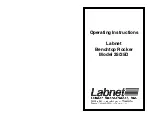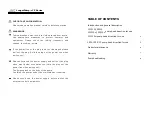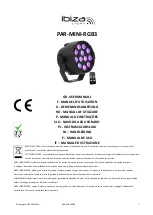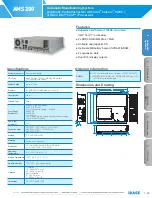
Making Measurements
Leaks
4-42
Using the LI-6400
4
quickly tell if the problem is physiology (reference is stable) or mechanical
(reference is unstable).
Average Time
You have at your disposal a configuration parameter that influences stability.
It is the ÒAvgTime=Ó command, which specifies the running average time for
the IRGAs. By default, it is 4 seconds, but you can raise or lower that number
if you wish. Chapter 16 discusses this and other configuration commands.
If you require the quietest possible signal, and can afford longer equilibrium
times, then you may want to raise this number to 10 or 20 seconds. If, how-
ever, you are trying to measure transients, or the system dynamics need to be
optimized, then set this to 0. This will give you 0.75 second averaging (thatÕs
the frequency of new measurements), at the price of slightly greater IRGA
noise than youÕd get at 4 seconds.
Leaks
In photosynthesis systems, there are two types of leaks: bulk flow and diffu-
sion. Bulk flow leaks occur when there is a hole (apart from the system inlet
and outlet) that allows air to move into or out of the system. Diffusion occurs
when a particular gas, such as CO
2
, moves through the walls of the system in
response to a concentration gradient.
Bulk Flow Leaks
The pressure inside the leaf chamber is slightly positive so that bulk flow
leaks tend not to be a problem. At low flow rates, however, this positive pres-
sure is more than offset in certain parts of the chamber by the chamber circu-
lation fan. This can have dramatic consequences: if the center O-ring on a leaf
chamber is missing, for example, ambient air can be sucked into the chamber.
¥
Check the O-rings
They have a way of escaping when you are changing chambers, so make sure
they are all in place.
¥
Check the gasket material
If the white gasket on the light source is flattened, change it. The black gasket
material (neoprene) can recover if left uncompressed overnight. When the
chamber is not being used, you can preserve your gaskets by adjusting the
thumb nut so that the gaskets are not compressed when the chamber is
latched.
Summary of Contents for LI-6400
Page 1: ...Using the LI 6400 Portable Photosynthesis System ...
Page 15: ...Part I The Basics ...
Page 16: ......
Page 174: ...Making Measurements Answers to Questions 4 56 Using the LI 6400 4 ...
Page 175: ...Part II Useful Details ...
Page 176: ......
Page 200: ...Standard Tools Power ON Hooks 5 24 Using the LI 6400 5 ...
Page 214: ...Real Time Data Real Time Graphics 6 14 Using the LI 6400 6 ...
Page 234: ...Environmental Control Light Control 7 20 Using the LI 6400 7 ...
Page 244: ...Light Sensor Considerations Gallium Arsenide Phosphide GaAsP Sensor 8 10 Using the LI 6400 8 ...
Page 288: ...Data Logging Making Your Own AutoPrograms 9 44 Using the LI 6400 9 ...
Page 289: ...Part III Working With Files ...
Page 290: ......
Page 312: ...The LPL File System Troubleshooting 10 22 Using the LI 6400 10 ...
Page 340: ...Downloading Files Using a Data Capture Program 11 28 Using the LI 6400 11 ...
Page 375: ...Part IV Configuration Issues ...
Page 376: ......
Page 420: ...Defining User Variables Old Style vs New Style 15 18 Using the LI 6400 15 ...
Page 454: ...Using an Energy Balance Further Reading 17 12 Using the LI 6400 17 ...
Page 455: ...Part V Maintenance Troubleshooting ...
Page 456: ......
Page 572: ...Troubleshooting Useful Information 20 46 Using the LI 6400 20 ...
Page 593: ...Part VI Programming ...
Page 594: ......
Page 622: ...Programming with LPL Compiler Directives 22 28 Using the LI 6400 22 ...
Page 846: ...Index I 16 Using the LI 6400 ...
















































